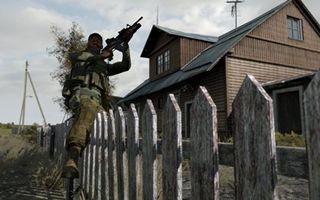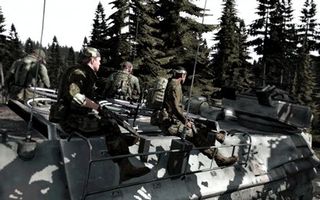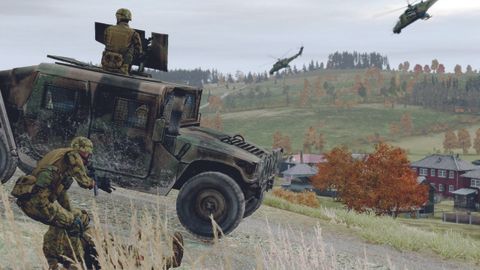When it all works as intended, ArmA II is an incredibly involving and complex military sim. The campaign moves quickly from linear, objective-based missions to open-ended areas of operation. You report to your superior, who gives you a daunting list of objectives spread across huge distances, three underlings to command, artillery support when required, and access to auseful helicopter taxi service. Arresting non-combatants, destroying key structures, wiping out insurgent bases – how you proceed is entirely your choice, and at times you’ll be asked to make decisions which have ramifications later in the campaign.
Having secured a small rebel ammo dump, for example, the local priest pleads with you to leave it there so that the rebels might better protect the village. Let him keep the guns and he’ll give you some useful intel, and when you report the cache to high command you get big props. Again the AI tends to put its foot in it in these situations, as if throwing a tantrum having had control taken away from it. For instance, as he pleaded withus the priest was gently rotating on the spot.

When not being pock-marked by oddness, everything about ArmA II is steeped in authenticity. When you begin to think your handgun feels pathetically weak, you can be fairly certain that’s because it’s just as flimsy in reality. Conversely, the assault rifles and heavy weapons might often sound reedy in the open air, but in no other game do they feel this deadly.
Accurate ballistics carry your rounds realistically to their destination, and to fire from a prone position at a target in the distance only to have your round thud into the dirt around him – well, it feels like serious business. You spend enough time not firing your weapon to make that moment of squeezing the trigger mean more than all of the endless rounds you’ll have fired in Call of Duty 4. Couple that with the pervading notion that where you’re firing from, who you’re firing at and why, has all happened by chance and choice, and you soon appreciate that this truly is an open-ended and unpredictable world.
Though you’ll spend a great deal of time chatting with locals and strolling eventlessly through villages, combat remains at the game’s core, and from low-level exchanges between your squad and straggling militia troops, right up to aerial and armoured combat, it’s intense, enthralling and exhaustingly realistic.
The original’s penchant for lengthy vehicle and weapon rosters returns, and you’ll be able to commandeer and pilot everything from hatchbacks and tractors to M1 Abrams tanks to Kamov Ka-52 gunships. The Armory mode acts as a playground for the game’s extensive cast of usable vehicles, throwing challenges at you (maintain an altitude, reach a top speed, etc) which allow you to unlock further vehicles in that game mode.
They’re all meticulously detailed too. The frequent encounters with helicopters hovering a few feet above the ground, beating the grass flat with their rotors’ downforce and kicking up a blinding cloud of dirt and dust in their wake, is one of the finest sights in any game.

Your ability to command your units is extensive and exact, though it’s hidden behind the fiddly and cumbersome interface. Said interface is at least consistent: you’ll use the same crappy menu system for ordering a single man into a barn as you will for commanding whole battalions to open fire. ArmA II’s interface, while powerful, is as intuitive as shitting in a wind tunnel. Immense reserves of patience are required to get the most out of it.
That’s perhaps the best summary of ArmA II you could hope for: it’s for the patient. There’s a fantastic military simulation here, with genuinely spontaneous moments of tense drama and elation arising from intelligent and dynamic systems, but it’s obscured by the awkward relationship between hard-scripting and dynamic AI, as well as the unfriendly interface. Fanswill look right past these problems and enjoy the game endlessly – and that’s sort of the point for Bohemia -they don’t seem terribly interested in presenting their game in a way thatattracts new players. ArmA II isthe pinnacle of fan service.
Where that ultimately leaves you depends on whether you’re “into this sort of thing”.
Jun 22, 2009


